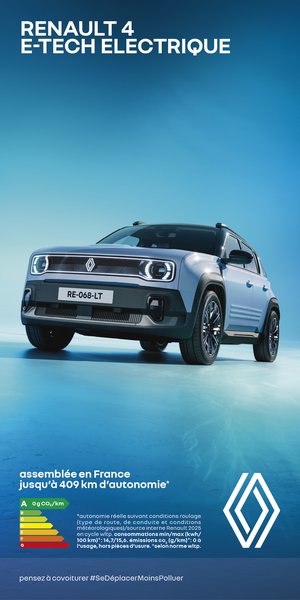Politique Internationale — Let’s put it bluntly: do we really need to develop electric vehicles?
Tommaso Pardi — Yes, it’s a necessity. First of all, there is the urgency of climate change: the challenges posed by global warming are sufficiently well recognized for us to tackle the issue head- on. However, the campaign against CO2 in the transport sector is struggling: if we consider road transport in the European Union (EU), it still accounts for 30% of emissions, and is failing to improve while other sectors have made significant progress.
Apart from the environmental issue, competition with China is the other main argument in favor of the development of electric vehicles. If Europe doesn’t step up a gear in this segment, it will be letting its powerful rival dictate the rules. By way of illustration, Chinese imports already account for a quarter of the EU electric vehicle market. China knows the advantages of a position of strength: it was at the forefront of combustion engine vehicles. Now it is faced with a true industrial revolution – with a target of 100% sales of new electric cars by 2035 – which means it must not be left behind.
P. I. — In the recent past, the context has changed a little. On the one hand, no one is talking any more about the programmed exhaustion of fossil fuels; on the other, carmakers are facing all kinds of difficulties. To what extent can these two factors penalize developments in electric vehicles?
T. P. — It’s true: in the 1970s, the notion of peak oil (the point at which hydrocarbon production would begin to decline — editor’s note) had gradually gained ground. But the prevailing view has been turned on its head, with the emphasis now on the abundance of fossil fuels and their cheap price. Is this reason enough to delay the fight against global warming? Certainly not. In the same way, developed economies must not relax their efforts against carbon, on the pretext that other less advanced countries have little or no comparable measures in place. As for the difficulties faced by automakers, they need to be put in perspective: manufacturers are emerging from an exceptional period, the post-Covid era, marked by demand outstripping supply, which led to an optimization of sales margins. As a result, some groups have accustomed the markets to operating margins of around 10%, whereas their performance generally averages around 5%, or even less. Let’s just say that we are witnessing a return to normality, albeit accompanied by industrial restructuring.
P. I. — What are the main obstacles to the growth of electric vehicles today? The price of vehicles is often cited first...
T. P. — To win over consumers, you have to be able to offer them something truly new. This is not currently the case for European manufacturers with electric cars. The decision was made to focus on top-of-the-range vehicles, in direct competition with SUVs, which are the preserve of affluent households. This logic can be explained: it allows manufacturers to pool production of electric cars on platforms already used for combustion engines. This applies in particular to parts assembly. But top-of-the-range means high prices: an electric car costs around 65,000 euros, i.e. 15,000 euros more than a combustion-powered vehicle of equivalent standing.
On the contrary, the novelty would consist in offering small electric vehicles, much lighter and less oversized than the current ranges. These would be cars that could replace the second vehicle often owned by households, the one generally used for short journeys, at least not for going on vacation. This type of car is capable of running on modest-sized batteries, unlike the top-of-the- range segment which requires an overcharge of up to 900 kilos.
P. I. — We’ll return to small electric cars. In the meantime, is the slow progress of electric cars linked to a problem of supply or demand? Should manufacturers be the first to be blamed for the narrowness of their range, or is it the consumer who is slow to be convinced of the merits of the revolution under way?
T. P. — In this matter, everyone tends to blame the other. The manufacturers point out that they have already made great efforts to get into electric vehicles. They’re not wrong: in just a few years, the share of electric cars in new car sales has risen from 3% to 15%. This growth is the result of a fast-paced ecological transition, for which companies are calling for increased public support. As for consumers, they are not opposed to electric cars – far from it. Many are aware of the ecological dimension of modes of transport and behave accordingly. However, the lack of novelty I’ve just mentioned, combined with the price variant and the feeling that electric vehicles are reserved for the privileged class, are factors that undermine the appetite for a different kind of motorization.
P. I. — Aside from price, the lack of charging stations is often cited as another obstacle on the road to electric vehicles. What’s your take on this?
T. P. — Compared to the existing electric vehicle fleet, at least in France, this is a false problem. Consider urban areas, where the frequency of short journeys encourages the use of electric cars: whether at apartment buildings, private residences, parking lots or equipped company sites, recharging facilities are developing and are easily accessible. Some regions are undoubtedly less well off than others, but the autonomy of these vehicles – with batteries capable of covering up to 600 kilometers – means that journeys can be envisaged with peace of mind. However, high-capacity batteries have a major impact on the weight and price of electric vehicles, which limits their spread. If the use of electric vehicles becomes more widespread and democratic, the problem will change: that’s why manufacturers are already calling on public authorities to work on plans for the massive installation of charging stations.
P. I. — We’ve talked about people’s reluctance to go electric, but what about plug-in hybrids? Doesn’t that represent a good compromise for consumers who are reluctant to move away from fossil fuels?
T. P. — Plug-in hybrids may be attractive on paper, but they’re much less so from an operational point of view, if we take the ecological argument further. These cars are heavy and, by definition, consume more energy. Above all, they are currently classified in an advantageous category, with regulations that place them close to the level of electric cars (which produce zero grams of CO2 per kilometer), with an emission rate that fluctuates between 30 and 50 grams. But in real-life driving conditions, we now have official data from the European Commission which shows that we are more like 80-120 grams due to much more frequent use in the thermal than the electric mode. However, such a level is not very far from the average 130 grams of a combustion-powered vehicle. This year, the legislation will take the plug-in hybrid out of its current category; it will be much less attractive than it is today, with inevitably lower purchase subsidies. Be that as it may, this segment is now statistically effective, since it has been integrated into new electric vehicle sales and contributes to their development. Even though, let’s repeat, the environmental impact is much more measured and regulations will lead to their virtual disappearance by 2035, on a par with other vehicles powered by internal combustion engines.
P. I. — Politics is very much at the forefront of the electric vehicle issue. But do we know exactly what the public authorities want and what they are prepared to implement, with 2035 and the ambitious target of 100% sales of new electric vehicles in their sights?
T. P. — The public authorities have a number of levers at their disposal. I’m not just talking about aid to industry or infrastructure development. They can also act with consumers, via taxation and carbon taxation in particular. However, when it comes to the population, we’re touching on sensitive subjects, as the Gilets jaunes crisis has revealed only too clearly. Politicians must take account of the electoral stakes in their thinking: they are prepared to influence the ecological trajectory in general, and that of the electric vehicle in particular, but only up to a certain point, so as not to upset the public, who ultimately have a means of sanction in the ballot box.
P. I. — Gerpisa has published a comprehensive report on the electric vehicle sector, which has just been released in bookshops: Légère et abordable: les clés d’une voiture électrique à succès (La Fabrique de l’industrie, 2025). You advocate the development of a small electric vehicle in Europe. Objectively speaking, what are the chances of success for this program?
T. P. — First and foremost, Gerpisa is not driven by a unilateral logic. On the contrary, we exchange views with all the players involved in the automotive world, including companies, government bodies, employee representatives, associations, etc. This diversity is in line with our purpose, which is to open up new avenues in addition to our analyses. In this context, we rely on economists as well as sociologists, historians, political scientists... A variety in the composition of Gerpisa that makes its richness. Four researchers in particular have contributed to this report: Marc Alochet at the École Polytechnique, Bernard Jullien at Bordeaux University, Samuel Klebaner at Sorbonne Paris-Nord University and myself. Our work is not limited to a thesis in favor of a light electric vehicle, but it is indeed a strong axis. Our starting point was this observation: the end, or thereabouts, of the production of category A cars by European manufacturers. This can be seen as damaging, as these models – like the Peugeot 205, Renault Clio, Fiat Panda and Opel Corsa – had helped to establish the reputation of these manufacturers. Not that these ranges have disappeared altogether, but their weight has increased as a result of regulatory demands for more on-board technology and safety.
At the same time, an examination of the situation abroad is instructive: Japan, for example, started later than France in developing electric vehicles, but it already has small vehicles that have proved their worth, as the success of the Kei Car testifies. The Kei Car meets precise standards: less than 3.40 meters in length, less than 2 meters in height and less than 1.48 meters in width. They have made it possible to replace old second-hand vehicles on a massive scale. The challenge now is to electrify these Kei Car models as much as possible. But the Japanese authorities are clearly moving in this direction.
P. I. — Notwithstanding the obstacles mentioned above, what’s preventing Europe from embarking on the adventure of the light electric vehicle?
T. P. — China’s ability to invest effectively in the electrical sector can be explained by the fact that the country started from nothing in this field; it was able to develop its industry ex nihilo and mobilize resources accordingly. There’s nothing comparable in Europe, where well-established infrastructures and processes make it impossible to pivot with the same speed. Take Germany, for example: groups such as BMW and Daimler Benz have based much of their success on sedans, and it would be hard to imagine them giving up all these assets. National specificities aside, another major obstacle on the road to the light vehicle lies in the inflation of standards, a difficulty shared by all industrial sectors. In concrete terms, when it comes to developing a new product, not only is there a recurrence of European directives on the subject in question, but these directives are in no way coordinated. In short, this excess of regulations – on safety, the environment, energy, materials, etc. – means that we have to be extremely inventive in order to comply with the texts. In the case of cars, the increase in weight is largely the result of these diktats, with the obligation to integrate a host of technical specifications.
P. I. — Isn’t any way of changing the situation?
T. P. — There have been some interesting initiatives, spearheaded by Acea (the European Automobile Manufacturers’ Association). In turn, a Manifesto and a Letter to Europe have been taken to Brussels: they advocate greater simplicity, coherence and clarity; they do not dispute the trajectory set by climate objectives, but call for resources to be dedicated to the automotive industry to support the environmental goals. In this context, the voice of Luca de Meo (CEO of Renault Group — editor’s note) sheds a particular light on the debate: he calls for an “Airbus of small electric cars” within a European framework. How can we not subscribe to this thesis? Taken individually, countries and their automakers don’t have the means to accelerate significantly in the electric sector. The investments required are so substantial that governments will be obliged to run up huge debts, at a time when budgets are being tightened everywhere. On the other hand, if Europe takes on the debt, the burden will be much easier to bear, if only because together we can obtain more attractive interest rates. That said, if this idea of an electric Airbus, which is beginning to take root, is to become a reality, sustained consultation will be required, the result of a real common desire.
P. I. — As a specialist, are you optimistic about the development of electric cars?
T. P. — Yes, because that’s the way history is going. We can’t continue along the same path with impunity, with ever heavier vehicles that may consume less energy than in the past, but which are highly energy-intensive to manufacture. Collaboration between the various countries is one of the keys: if everyone submits to the same criteria and pools their skills, the EU can offer a credible electric alternative to Chinese imports.



















